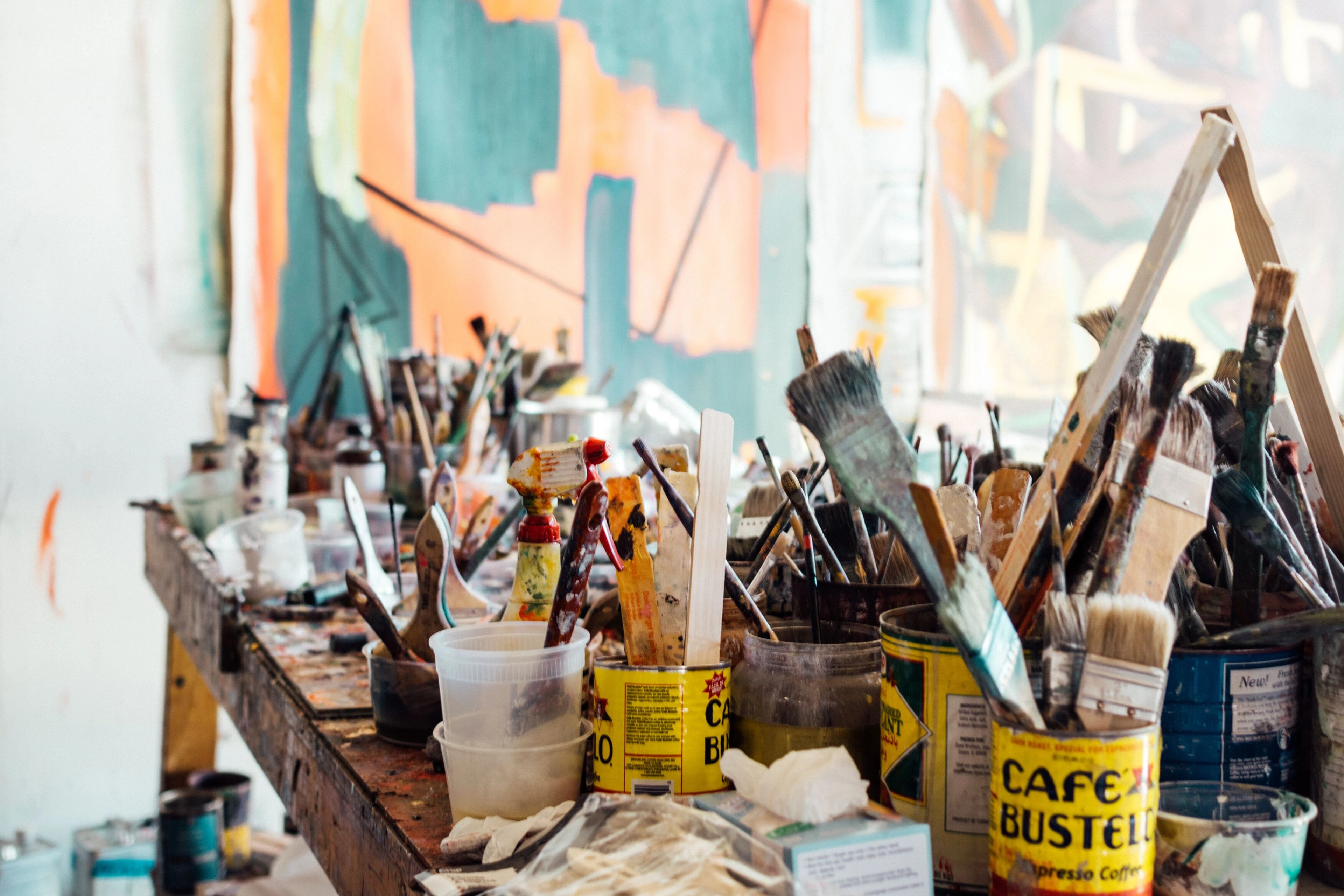
Decoding My Abstract Language: Personal Symbols, Art, & Your Story
Discover the unique visual language in my abstract art. Learn to interpret personal motifs, colors, & gestures, and find your own stories within non-representational paintings.
My Abstract Language: Decoding Personal Symbols & Finding Your Own Story
You know that feeling when someone tells a story, and you're nodding along, but inside you're thinking, 'I have no idea what they're talking about'? Yeah, sometimes abstract art can feel a bit like that. It's often perceived as an exclusive club, where only the initiated can truly understand. And while there is a deeply personal language woven into every piece I create – a kind of visual diary of my own life – it's definitely not meant to be a secret. In fact, it's quite the opposite. This isn't just about my story; it's about inviting you into a dialogue, to discover your own narratives within the lines, colors, and textures. My goal here is to pull back the curtain, demystify my creative process, and offer you a personal guide to decoding my abstract language by exploring my unique visual vocabulary and interpreting the recurring motifs, colors, and gestures that define my non-representational works, inviting you to discover your own narratives within the brushstrokes. Let's find your own stories within the brushstrokes, shall we?
What Exactly is "My Abstract Language"?
Before we dive into my personal approach, let's briefly touch on what abstract art, in its essence, often aims to achieve: a bypass of literal depiction to convey emotion, concept, or pure form. But it's often more than that. For me, and for many artists, it’s also about exploring the depths of the subconscious, challenging our perceptions of reality, or simply celebrating pure aesthetic exploration—the beauty of line, color, and texture for their own sake. When I sit down to paint, I'm not trying to replicate a scene or a person. My canvas becomes a space for emotional exploration and internal dialogue, a deliberate step away from the literal, allowing raw feeling to take center stage. My "abstract language" is the unique vocabulary and grammar I've developed to express complex emotions, fleeting memories, and evolving ideas that can't be captured by conventional words or literal images. Every stroke, every color choice, and every layer is a word, a phrase, a sentence in this non-verbal conversation. It's less about depicting reality and more about conveying the feeling or essence of reality – the raw, unfiltered experience of it. It’s an honest portrayal of my inner world, the kind of conversation you have with yourself when no one else is listening. It’s a profound way for me to connect with the unspoken, to understand my own place in the world, and to invite you into that understanding. Learn more about why I paint abstract and its unique power.
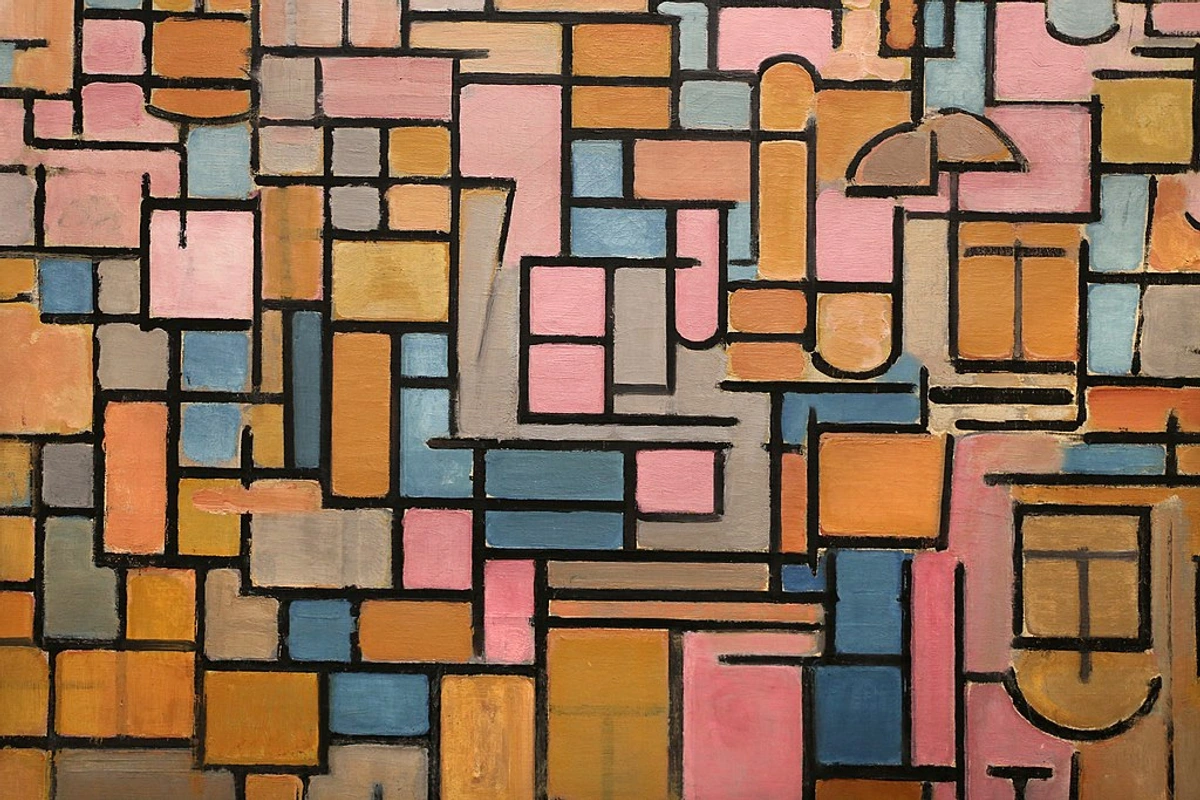
A Brief Look Back: The Roots of Expressive Abstraction
While my abstract language is deeply personal, it stands on the shoulders of giants. Abstract art didn't emerge in a vacuum; it evolved from a profound desire to move beyond literal representation, often to express inner worlds. Pioneering artists like Wassily Kandinsky, for example, believed art should convey spiritual and emotional truths through color and form alone, without needing to depict objects from the physical world. This resonates deeply with my own conviction that art can speak directly to the soul, bypassing the need for explicit narrative. But let's not forget groundbreaking figures like Hilma af Klint, who created truly abstract works well before many of her male counterparts, driven by spiritual exploration and an intuitive process that feels remarkably contemporary. Later, movements like Abstract Expressionism, with artists such as Jackson Pollock and Mark Rothko, further pushed the boundaries, turning the canvas into an arena for raw emotion and the artist's psychological state. This rich history of abstract art underscores the profound human need to communicate beyond words, a tradition my own work humbly continues, albeit with my own distinct voice and contemporary sensibilities. Explore the passion of expressionism to see how art captures raw emotion. But before we delve deeper into the what of my visual vocabulary, let's briefly touch upon the how – the materials and techniques that enable this expressive conversation.

Materials & Techniques: The Language's Medium
But how does this language actually manifest on the canvas? While the previous sections focused on what my language expresses, it's also important to acknowledge how it's spoken. My choice of materials and techniques is not arbitrary; it profoundly influences the texture, depth, and overall emotional resonance of each piece. I primarily work with high-quality acrylics, which allow for rapid layering, creating a dynamic interplay of transparency and opacity. The fast drying time means I can build up histories quickly, much like memories stacking upon one another in our minds, making acrylics the ideal medium for capturing the fleeting nature of my subconscious expressions. Beyond the paint itself, the tools I use are extensions of my gestural language: wide brushes for sweeping declarations, palette knives for sharp incisions or thick, textural impasto, and even rags or my own fingers for blending and softening, adding an intimate, human touch. Each decision, from the coarseness of the canvas to the viscosity of the paint, is a deliberate choice in shaping the visual narrative, a subtle whisper within the broader conversation of my art.
The Building Blocks of My Visual Vocabulary
Just like any language, mine has its fundamental components. These aren't rigid rules, mind you, but rather recurring tendencies and personal associations that give my work its distinct voice – elements I invite you to interpret through your own lens.
Motifs & Recurring Shapes: The Silent Characters
Have you ever noticed a shape or a symbol that seems to follow you through your thoughts, or even your dreams? Just like those persistent ideas, sometimes a particular swirl reappears across different works in my collection, or a sharp, jagged line cuts through a composition. These aren't always consciously chosen; sometimes they just... emerge from the depths. They act as silent characters in an unfolding drama, representing persistent themes or subconscious echoes within me, each carrying a whisper of meaning. A flowing, organic form might signify connection or growth, while a more angular, fragmented shape could speak to uncertainty or change. What's fascinating is how these motifs can evolve over time, too, subtly shifting their meaning as I grow and change – mirroring my own artist's journey. For instance, a recurring, slightly off-kilter spiral in my early work often represented the feeling of being lost in a moment of overwhelming decision, a sense of swirling uncertainty. Now, in newer pieces, that same spiral often appears more grounded, perhaps partially enclosed or leading into another form, symbolizing finding clarity within the chaos. It’s a testament to the idea that our personal symbols are never static. Honestly, sometimes I think these shapes have a mind of their own, demanding their presence be known!
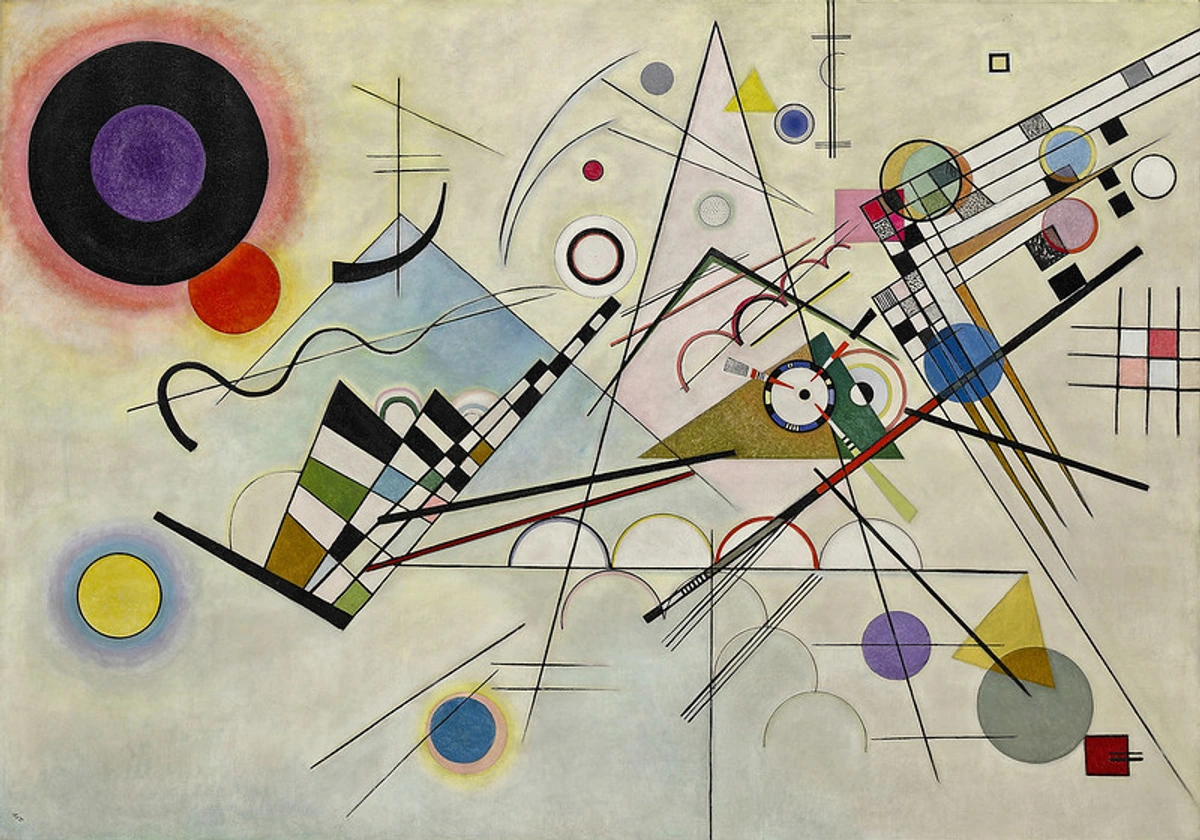
Color: The Emotional Spectrum of My Soul
Colors in my art aren't just pretty; they're potent, capable of jolting me awake or lulling me into a dream. My palette is my story, deeply personal and rooted in how I experience the world. A vibrant yellow might be a burst of unexpected joy – like the exhilarating feeling after a breakthrough in the studio; a deep indigo could signify profound introspection during a quiet, rainy afternoon, or a splash of fiery red, a moment of intense, undeniable passion. I recall one piece where a particular cadmium orange, usually a symbol of vibrant energy, shifted its meaning after a period of intense creative block, now representing the defiant warmth of perseverance pushing through doubt. It’s like my own personal emotional kaleidoscope, each hue a direct conduit to a specific memory or an overwhelming feeling, whether it’s the quiet comfort of an autumn morning or the exhilarating rush of a new idea. But it’s not just about individual colors; it's about how they dance together – how a cool blue meets a warm orange, or how a splash of green might temper a fiery red. These combinations create a deeper, more nuanced emotional narrative, a symphony of feelings. While universal symbolism plays a small part, the focus is profoundly on my personal, emotional connection to each hue, building my unique emotional language of color in abstract art. I've often found myself drawn to the psychology of blue, using it to anchor feelings of calm and expansive depth.
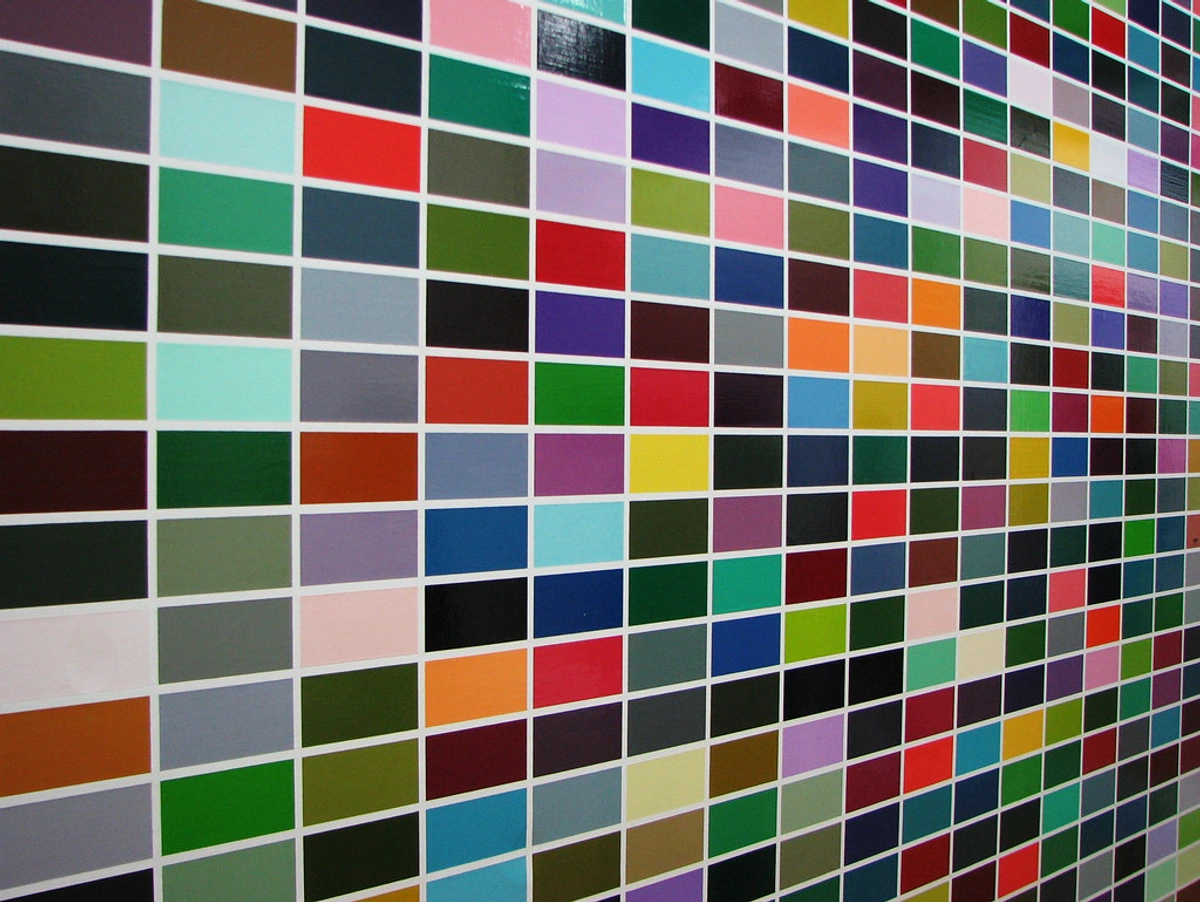
Gestures & Marks: The Unspoken Dialogue
The way I apply paint – whether it's thick impasto, delicate glazes, or sweeping gestural marks – carries an undeniable energy. It's like the tone of voice in a conversation, adding layers of nuance and emphasis, like the subtle inflection in a spoken word. A furious scrub, applied with physical force and sometimes the edge of a palette knife, might convey frustration or the urge to erase; a gentle blend created with delicate control might speak of acceptance or quiet merging, or a sharp, decisive line could represent a moment of sudden clarity, a break in the clouds. Think of the difference between a spontaneous, almost violent flick of the wrist and a slow, deliberate drag of a heavily loaded brush – each creates a vastly different emotional weight, a whisper versus a shout. These marks are the immediate, visceral record of my presence and emotion during the creative flow, etched directly onto the canvas. They are a direct, raw imprint of my state of mind, a physical conversation with the surface. Find out more about the language of line in my work.
Layers & Depth: The Unfolding Narrative of Time
Just like our lives, my paintings often have many layers. What you see on the surface is built upon histories – hidden colors, scraped-back textures, faint lines that peek through. These layers aren't just technical; they suggest memory, the passage of time, the complexity of emotions that build up, or the underlying foundations of a feeling. For instance, a faint, almost obscured layer of deep blue beneath a vibrant yellow could represent a period of quiet sadness that was eventually overcome by a burst of joy, a subtle resilience woven into the very fabric of the piece. Often, I'll deliberately scrape back a layer to reveal the ghost of a previous thought, or glaze over another to hint at what lies beneath, a subtle resilience woven into the very fabric of the piece. It’s the visual equivalent of an archaeological dig into the self, inviting you to unearth its secrets and uncover the story of its creation. Discover the language of layers and how I build depth in my acrylics.
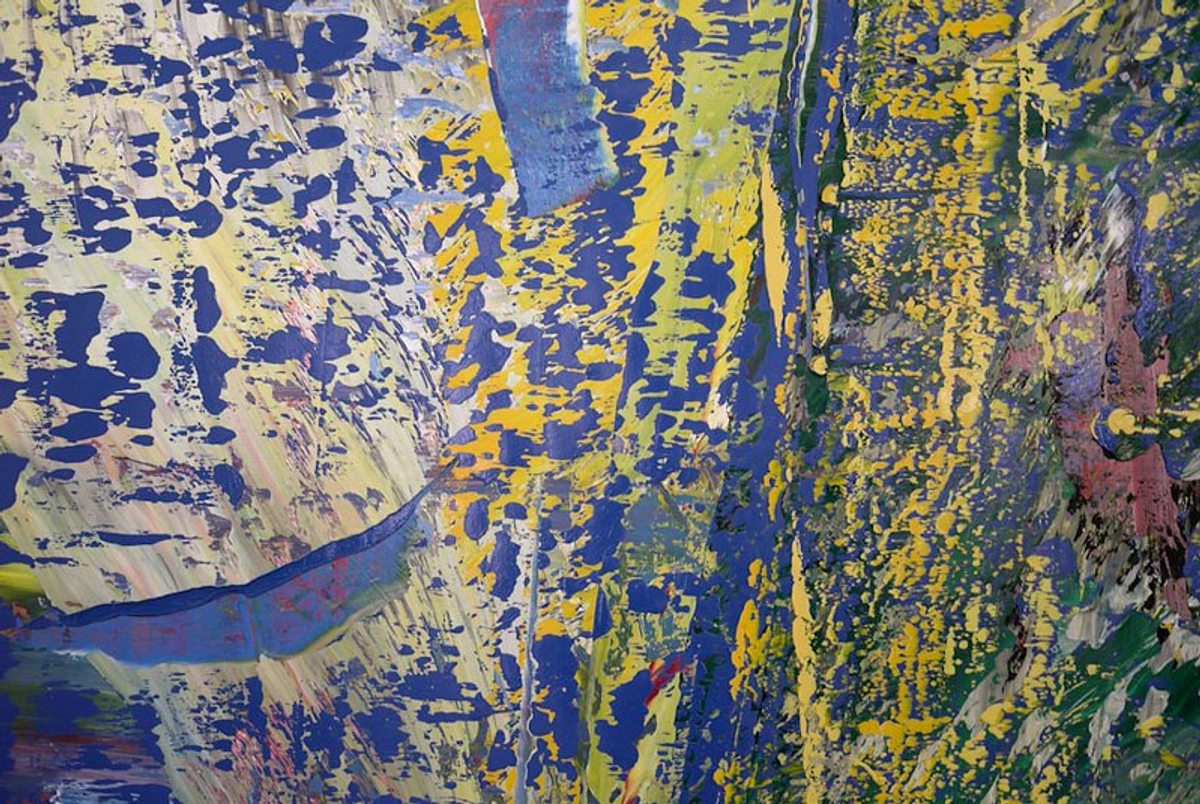
The Evolution of a Visual Voice: My Language Over Time
My abstract language isn't static; it's a living entity, constantly evolving alongside my own journey and the world around me. It's a continuous dialogue between who I am and what the canvas asks of me, or perhaps, what the world whispers to my subconscious. Early on, my compositions might have been more about raw energy, bursts of primary colors reflecting youthful intensity and a more direct emotional expression. Over the years, as my perspective broadened and my inner landscape shifted – sometimes gently, sometimes with a jolt from a new relationship or a significant societal shift – you might notice a more nuanced approach to color, perhaps a richer layering that speaks to accumulated experience, or even quieter, more meditative spaces within the canvas. For example, after a transformative trip through the rugged landscapes of Patagonia, my palette subtly shifted towards earthier tones, and sharp, sweeping marks began to appear, reflecting both the grandeur and the challenges of that experience. Later, a profound period of self-reflection following a significant personal loss led to softer, more blended forms, a visual echo of my pursuit of internal peace and acceptance, a quiet integration of sorrow. It’s never a conscious decision to 'change' my style, but rather an organic blossoming that mirrors my internal and external shifts. This ongoing transformation is a core part of finding my voice.
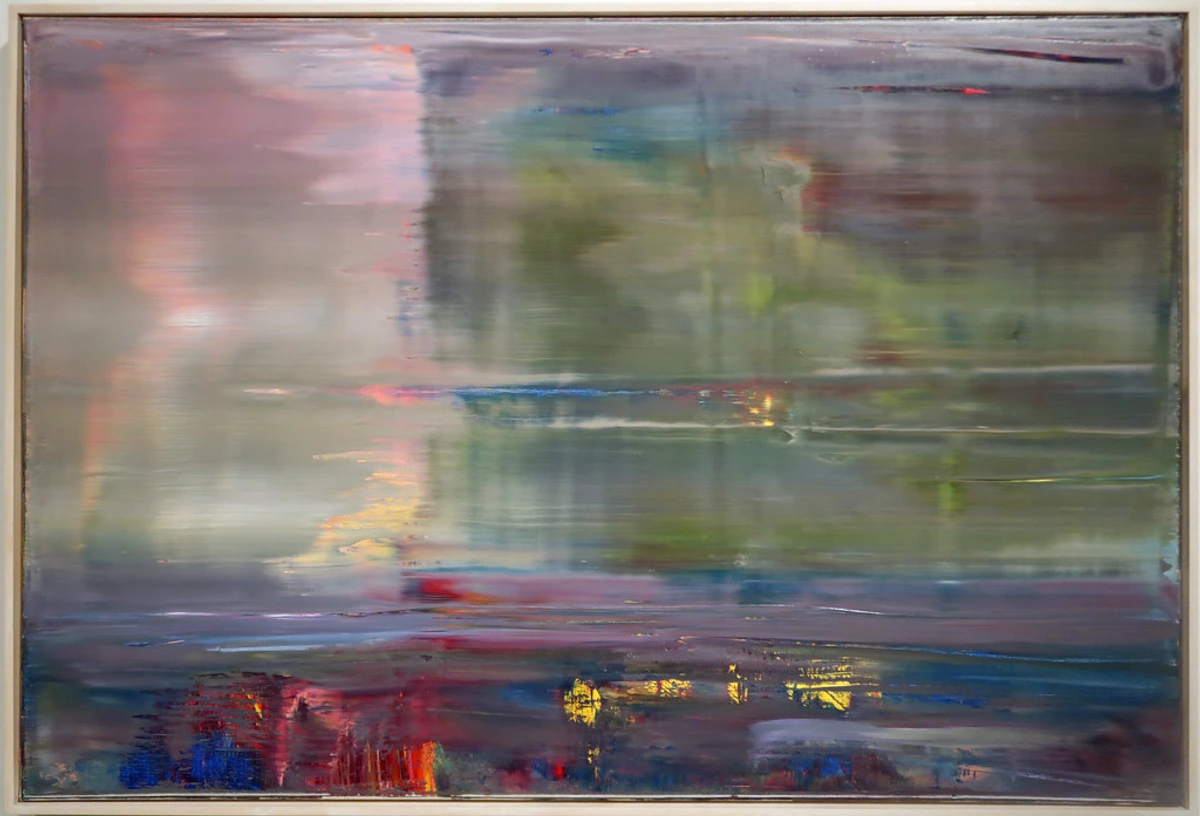
From Inner World to Outer Canvas: Infusing Personal Narratives
So, how do these building blocks come together to form a coherent, albeit abstract, narrative? It’s a messy, beautiful dance between intention and surrender.
Intuition as a Compass, Not a Map
My intuitive painting process is where this language truly forms. It's rarely a rigid plan; sometimes, I just let the brush go, allowing my subconscious to guide the narrative. It’s like when you’re talking, and a word just pops out – sometimes surprising even yourself with its aptness. That's how my compositions often begin, a conversation between instinct and intent. Sometimes, my subconscious has a much better sense of direction than I do, which can be both liberating and slightly terrifying! I often resist at first, trying to impose my own will, only to find the painting fighting back until I surrender. Once, I had a piece that just wasn't working; I kept trying to 'fix' it,' but it felt stiff. Then, I finally gave in, allowed a seemingly random, sweeping stroke of cadmium yellow, and suddenly, the whole piece clicked into place, brimming with an unexpected energy I couldn't have planned. It's like when you stubbornly insist on one route, only for the universe (or your brush) to gently nudge you onto a more beautiful, unforeseen path. It’s like trusting a GPS that only speaks in riddles, but somehow always gets you to an unexpected, yet perfect, destination. My job is simply to listen, to embrace the whisper of the subconscious.
Moments of Inspiration: Echoes, Not Replicas
A quiet walk in nature, a poignant piece of music (my studio playlist), a compelling piece of literature, meaningful conversations, or even the subtle texture of an old stone wall can all leave imprints that find their way onto the canvas, translated into my abstract lexicon. I even find inspiration in the everyday chaos – a tangled knot of headphone cords might spark a frenetic line, or the perfect imperfection of a chipped coffee mug could inspire a layered texture. Sometimes, it's even more abstract – like pondering the concept of 'impermanence' after watching a cloud dissolve, or the feeling of 'connection' after a truly profound conversation. It's rarely a direct representation, more of an emotional echo, a mood, or a distilled experience. For instance, after a particularly frustrating hour spent untangling headphone cords, a tangled, agitated line unexpectedly found its way onto my canvas in my next painting, a raw visual echo of that inner turmoil. Coincidence? Maybe. Or maybe my abstract language was just having its say, letting off a little steam through my brush – a far more productive outlet than yelling at inanimate objects. Explore more about the artist's muse and its role in creation.
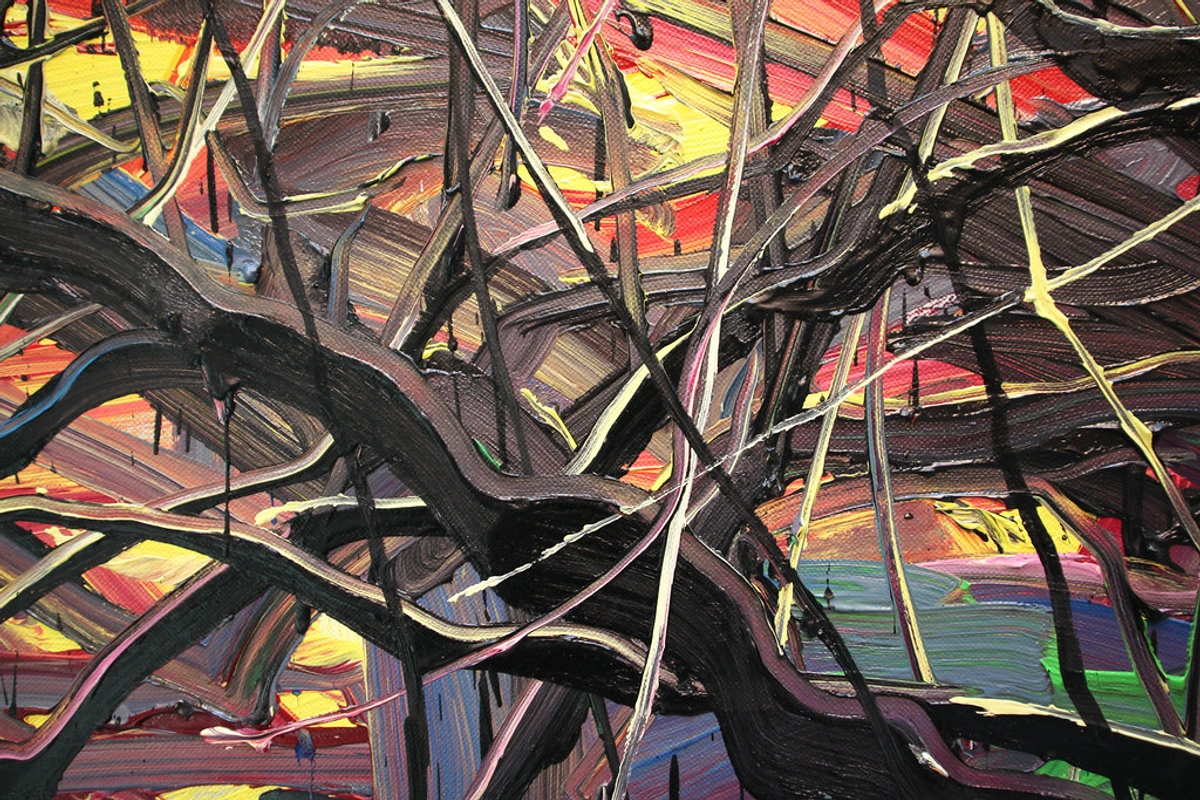
Your Role in the Conversation: The Magic of Interpretation
The real magic happens when you, the viewer, step in. You bring your own experiences, your own 'language,' to the piece. My abstract art isn't a puzzle with one right answer; it's an open invitation. What do you see? What does it make you feel? Your interpretation is not just valid, it's essential. To help unlock your own narrative, try asking yourself: 'What color or shape here feels like a memory from my own life?' It completes the circuit, turning my personal narrative into a shared experience. What unspoken narratives might be waiting to be discovered within your own life? Perhaps a forgotten memory surfaces, or a new emotion is brought to light, proving that abstract art truly is a mirror to your inner world. In essence, you are finding your reflection in my art.
Decoding My Work: A Practical Example
To illustrate how these elements coalesce and how you might interpret my personal language, let’s imagine a hypothetical piece from my collection, perhaps titled "Echoes of a Silent Dawn." On first glance, you might be drawn to a dominant, soft indigo wash that slowly transitions into hints of warm ochre. This indigo, for me, often represents quiet contemplation, the stillness before the world awakens, while the ochre might be the first blush of possibility – the feeling of hope that follows introspection, much like the gentle promise of a new day. Cutting through this, a series of delicate, yet deliberate, white gestural marks might trace pathways – like thoughts forming in the pre-dawn quiet, or perhaps the faint, tentative steps of starting something new. There’s a faint, almost obscured layer beneath the indigo, a barely visible network of intertwined lines in a darker blue; this could be an older memory, a foundation of quiet resilience that informs the present moment, a subtle echo of past struggles overcome. A recurring, somewhat broken, circular motif might emerge near the center, not perfect, but striving for completion – perhaps symbolizing the continuous effort to find peace or resolution, or the cyclical nature of growth and renewal. And even the negative space, the quiet areas around these elements, contributes to the overall feeling, allowing moments of visual breath and emphasizing the main forms, creating a subtle compositional balance. Each element, though non-representational, works in concert to evoke a specific emotional landscape, one that I hope resonates with your own experiences of new beginnings and internal journeys.
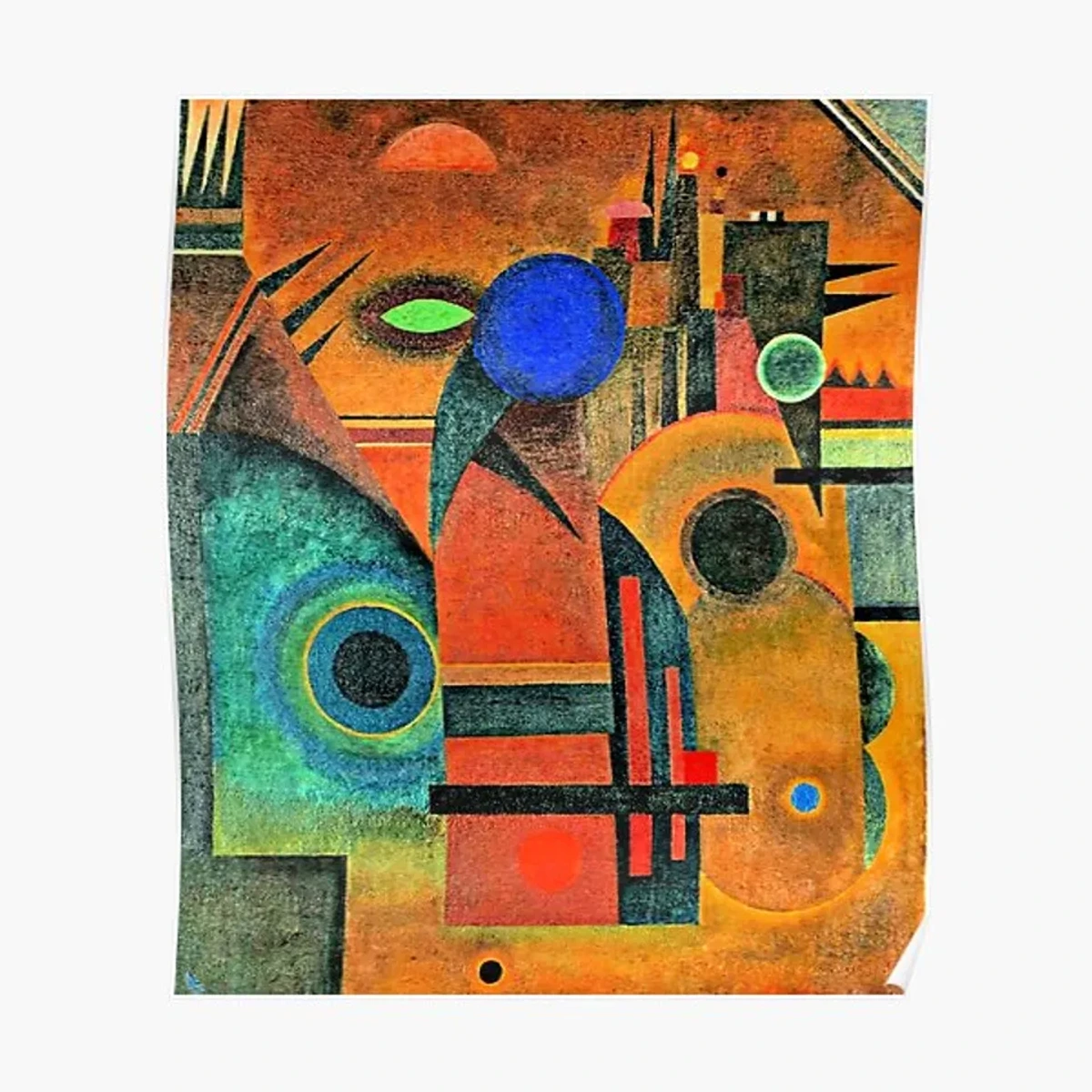
How to Engage with Abstract Art: A Viewer's Guide
So, you’re ready to dive in and find your own narrative within the lines and colors? Excellent! Here are a few ways to begin that journey, turning observation into a deeply personal experience:
- Start with your gut feeling: Don't overthink it. What colors draw you in? What shapes feel familiar or unsettling? Let your initial, visceral reaction guide you. There's no right or wrong answer when it comes to feeling. This approach can really help in demystifying abstract art and making it approachable. Try this with the next piece you encounter in a gallery or online. Take a moment now: look at the Kandinsky image above – what's the first color that catches your eye, and what emotion does it spark for you?
- Let your eyes wander: Don't search for a hidden object. Instead, allow your gaze to move across the canvas, noticing textures, lines, how elements interact, and where your eye naturally settles. It's like listening to music without lyrics – you're absorbing the composition. Allow yourself to get lost in the visual rhythm. Learn how to abstract art with these techniques.
- Connect to personal memory or emotion: Does a particular splash of color remind you of a specific moment? Does a certain brushstroke evoke a feeling of calm or chaos? For a deeper connection, try closing your eyes for a moment, recalling a strong feeling or memory, then open them and see if any part of the painting resonates with that feeling. Use the artwork as a prompt for your own internal landscape. This is key to decoding abstract art effectively.
- Consider the artist's context (gently): While not essential for your interpretation, knowing a little about the artist's general themes or intentions can add another layer of appreciation, offering a gentle nudge without dictating meaning. But remember, your personal response always comes first.
- Revisit: Abstract art often reveals more with repeated viewing. What you see or feel one day might evolve the next, just like your own experiences. Don't be afraid to come back to a piece and see what new stories it tells you.

FAQ: Decoding Abstract Art Together
Let's tackle some common questions you might have about engaging with abstract art, particularly my own:
- Q: Do I need to know your personal story to understand your art?
- A: Absolutely not! While my art is rooted in my experiences, the beauty of abstraction is that it bypasses literal interpretation. Think of it as music – you don't need to know the composer's life story to feel the emotion. It's about resonance. What matters is how you connect to it, the feelings it evokes within you. My intention is to create a universally resonant experience, despite its personal origins.
- Q: What if I see something different from what you intended?
- A: That's the goal! My intention is to create a starting point, a visual prompt. Your interpretation is valid and wonderful. It means the artwork has connected with your unique inner world. I've often had people tell me they see a landscape in a piece I thought was about inner turmoil, and I find that fascinating. It enriches the art itself! It's like finding a secret message in a song that only you can hear.
- Q: How do you choose the titles for your abstract pieces?
- A: My titles are often a final layer of my personal language. Sometimes they emerge during the creative process, a word or phrase capturing the dominant emotion or a flash of inspiration that arose directly from a particular visual element or the feeling that emerged as the painting took shape. Other times, I wait until the painting is complete, allowing its own visual voice to suggest a title that offers a gentle hint, rather than a literal explanation, inviting viewers to explore their own connections without dictating meaning. It’s like giving a newborn a name – you wait to see who they are before you label them, trying to capture their essence without defining their entire future. Learn more about how I choose titles.
- Q: What if I generally find abstract art challenging or unappealing?
- A: That's perfectly natural! Abstract art often asks us to engage differently than representational art. Instead of trying to 'figure out' what it 'is,' try approaching it like a piece of music or a vivid dream. Let go of the need for literal meaning. Focus on the sensations: do the colors make you feel energized or calm? Does the movement in the piece feel chaotic or harmonious? Sometimes, the most rewarding connections happen when we allow ourselves to simply experience it without judgment. Give it a few chances; sometimes it's an acquired taste, like dark chocolate or a profound conversation.
- Q: How do you know when a piece is finished?
- A: Ah, the eternal question! For me, it's a feeling – a deep, resonant 'click.' It's when the dialogue between me and the canvas feels complete, when there’s nothing left to add or take away without disrupting its inherent balance and message. Sometimes it’s a sudden realization, other times it’s a slow dawning, but there’s always a point where the painting begins to speak for itself, declaring its own completion. It's less about reaching a perfect state and more about achieving a profound sense of rightness, even if it's imperfect. It’s like finishing a good book – you just know when the story has run its course.
Conclusion: An Open Invitation to Dialogue
My abstract language is a living, breathing entity. It's how I explore the messy, beautiful, and often contradictory tapestry of being human. And while I offer you glimpses into my personal symbolism and narratives, the ultimate gift is the space it creates for you. A space to reflect, to feel, and to perhaps, even decode a little bit of your own story within the brushstrokes. Ready to explore further and truly engage in this dialogue? I invite you to delve into my collection of abstract art and discover a piece that speaks directly to your soul, becoming a catalyst for your own reflection. Or, if you're ever in 's-Hertogenbosch, drop by my museum to experience the language firsthand and trace my artist's journey through the years. The conversation awaits, open-ended and full of possibility – and perhaps, a new discovery about yourself and the stories waiting to be found within my abstract language!
Find your own stories and connections within my abstract language.




